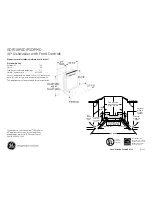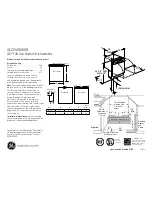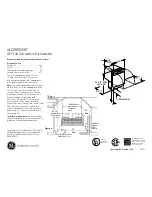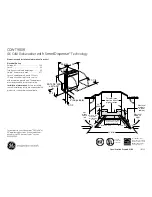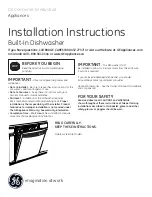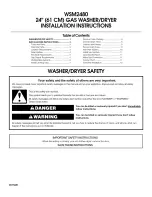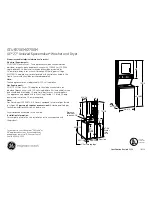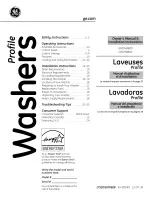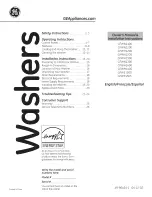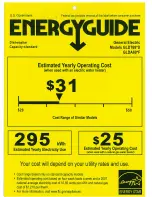
NOTE: Water pressure under 138 kPa [20 pounds per
square inch] will cause an extended fill time in the
washer.
The appliance is to be connected to the water mains using new
hose-sets and the old hose-sets should not be reused.
Turn on the water supply faucets and flush the lines for approxi-
mately two minutes to remove any foreign materials that could
clog the screens in the water mixing valve. This is especially im-
portant when installing your washer in a newly constructed or
renovated building. Build-up may have occurred during construc-
tion.
Connecting Hoses
1. Insert rubber washers and filter screens (from accessories
bag) in water fill hose couplings (two hoses supplied with
washer). The filter screen must be facing outward.
Models Through Serial Nos. Beginning 1810:
NOTE: If using gray braided hoses with silver hose
couplings (one with hex nut): Insert filter screens in-
to the hex nut shaped hose couplings (BSPP
thread). Insert rubber washers into the knurled,
round shaped hose couplings (GHT).
Models Starting Serial Nos. Beginning 1810:
NOTE: Water mixing valve connections at rear of
washer are BSPP thread. Both hose couplings on fill
hoses included with machine are also BSPP thread.
2. Connect fill hose couplings with filter screens to water supply
faucets.
3. Connect the other hose couplings to the hot and cold valve
connections at the rear of the washer.
Models Through Serial Nos. Beginning 1810:
NOTE: If using gray braided hoses with silver hose
couplings (one with hex nut): Connect the hex nut
shaped hose couplings (BSPP thread, with filter
screens) to the water supply faucets. Then connect
couplings with knurled, round shaped couplings
(GHT) to the hot and cold water mixing valve con-
nections at rear of washer.
Models Starting Serial Nos. Beginning 1810:
NOTE: Water mixing valve connections at rear of
washer are BSPP thread. Both hose couplings on fill
hoses included with machine are also BSPP thread.
4. Make sure the hose from the hot water faucet goes to the wa-
ter mixing valve marked “H” and the hose from the cold fau-
cet goes to the valve marked “C”.
5. Thread hose couplings onto valve connections finger tight.
Then turn 1/4 turn with pliers.
IMPORTANT: DO NOT cross thread or overtighten
couplings. This will cause them to leak.
6. Turn water on and check for leaks.
7. If leaks are found, retighten the hose couplings.
8. Continue tightening and rechecking until no leaks are found.
COLD
HOT
TLW2264N_SVG
C
H
8
7
6
5
4
3
2
1
1.
Filter Screen (Screen must be facing outward)
2.
Fill Hose
3.
Plain Rubber Washer
4.
Cold Water Connection
5.
Hot Water Connection
6.
Install this end of hose to valve connections at rear of
washer
7.
Install this end of hose to water supply faucet (Hex nut
shaped coupling for BSPP thread)
NOTE: Both couplings on fill hoses included with
models starting Serial Nos. beginning 1810 are
BSPP thread.
8.
Faucet
Figure 4
IMPORTANT:
Hoses and other rubber parts deteriorate after exten-
ded use. Hoses may develop cracks, blisters or materi-
al wear from the temperature and constant high pres-
sure they are subjected to.
All hoses should be checked on a monthly basis for
any visible signs of deterioration. Any hose showing
the signs of deterioration listed above should be re-
placed immediately. All hoses should be replaced ev-
ery five years.
IMPORTANT: Turn off water supply faucets after check-
out and demonstration. Owner should turn off water
supply whenever there will be an extended period of
non-use.
Connect Drain Hose to Drain
Receptacle
1. Remove the drain hose from its shipping position on the rear
of the washer by unhooking the hose from the retainer clamp.
2. Install the drain hose into the drain receptacle (standpipe, wall
or laundry tub) following the instructions below.
NOTE: Drain receptacle must be capable of handling
a minimum of 32 mm [1-1/4 inch] outside diameter
drain hose.
Installation
©
Copyright, Alliance Laundry Systems LLC -
DO NOT COPY or TRANSMIT
7
Part No. 204301ENR1
Summary of Contents for AWNE8
Page 2: ......














